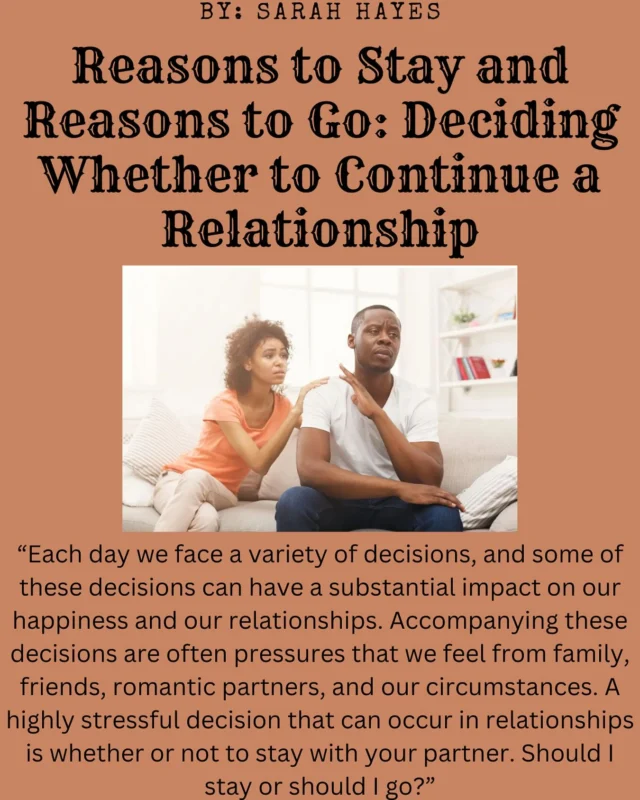Dating and forming romantic relationships during the age of ambiguity can be incredibly confusing, especially if your romantic partner seems uninterested in a committed relationship. As a research team we have had frequent discussions about the missed opportunities (see here and here), and emotional toll of investing years of your life into a relationship with no future. For some romantic relationships, individuals may feel constrained (feel pressure) to stay in a relationship even if it is unhealthy. The decisions and investments we make in our romantic relationships can “lock us in” and make it more challenging to breakup. This becomes especially problematic if we do not see a future with our partner, or if the relationship is dysfunctional or even abusive. In a research study by Kayla Knopp and her colleagues at the University of Denver they found that these constraints can lead to psychological distress and anxiety about abandonment (Knopp, Markman, Rhodes, & Stanley, 2015). However, these researchers also found that constraints “feel” different if there is more commitment to the relationship.
Constraints can be either be positive (building a life together, having a family) or negative factors in a relationship but could also lead to an individual feeling trapped in the relationship. When analyzing constraints, it is vital to understand how the individual feels about their relationship. The level of commitment in a romantic relationship has a major impact on the outcome. It is vital to recognize what influences the couple’s motivation to stay committed. For example, there is a significant difference between “wanting to” versus “having to” stay together in a relationship (Knopp et al., 2015). As opposed to personal dedication (desire to stay in relationship), Stanley and Markman (1992) defined constraint commitment in the following way:
“In contrast, constraint commitment refers to forces that constrain individuals to maintain relationships regardless of their personal dedication to them. Constraints may arise from either external or internal pressures, and they favor relationship stability by making termination of a relationship more economically, socially, personally, or psychologically costly.” (p. 4)
Couples may feel the pressure to stay together due to various factors, such as pressure from friends and family, cohabitation, sharing financial responsibilities, etc. When combining love and commitment, it creates an ideal formula for happiness and success in a romantic relationship. But what happens when when one partner has more dedication (commitment) to the relationship than their partner has? In other words, what do you do if your partner is the weak link in your relationship? This behavior has an influence on the anxiety and level of dedication within the romantic relationship. Couple relationships function best when both partners are equally committed to the future of the their relationship. Although we have used the video below in other blog posts, this video by Prep about decision making in romantic relationships feels especially relevant to include here.
This lack of commitment and the desire to stay in a relationship perhaps influences the constraints within a romantic relationship. There are three various perspectives of constraints. Listed below are the perspectives provided by Knopp et al. (2015):
- Perceived Constraints: These constraints pose as barriers that could restrict the couple from breaking up. For example, the pressure from friends and family could perhaps limit the couple from ending their romantic relationship. Friends and family can have a major impact on the way some individuals view their relationship. Furthermore, if an individual has a close relationship with their friends and family, the might prolong the relationship. Due to the support they are receiving and not wanting to disappoint their friends and family.
- Material Constraints: This represents the tangible constraints a couple has created in their relationship. An example would be, sharing a lease with your romantic partner or adopting a puppy together. During that moment, it may appear as the right thing to do but it could result in causing more conflict. This is where it is important to understand sliding vs. deciding. Princess the puppy may present itself as a fun and mature thing to possess, but what happens when the level of commitment begins to decrease. It is vital to make conscious decisions before sliding into a scenario that might not be the best fit for your future plans.
- Felt Constraints: These constraints are based on an individual’s feelings. This can stem from the feeling of being trapped in the relationship by external pressures. For example, an individual may feel pressured to stay in the relationship because they do not want to feel the sense of abandonment. Or perhaps they have been with their romantic partner for several years and cognitive distortions clog their thoughts and emotions. One cognitive distortion would be black and white thinking. An individual might feel if I end my romantic relationship, I will never find someone that loves me the same.
There are various factors that influence a romantic relationship. It is vital to have the basic understanding of the level of commitment and desire in your relationship. This will ultimately benefit the relationship when planning the future together. When constraints appear in the relationship, it will either cause the individuals to pull for togetherness or create distancing. Therefore, it is important to identify how one is feeling about their romantic relationship. Separating the feelings between “wanting to” versus “having to” stay together is important when identifying the level of happiness and commitment in the relationship. Knopp and colleagues (2015) explain further:
“Constraints may feel different or operate differently depending upon the amount of dedication one feels towards a relationship. More specifically, constraints are associated with more negative feelings when dedication is low” (p. 131).

Dr. Scott Stanley emphasized this idea in a blog post published in 2014:
“We live in a world of anxious love, longing, and avoidance. Early on in relationships, this may be merely annoying. Over time, I believe it becomes positively dangerous. One of the greatest risks in romance is when one person invests significant emotional energy in another, only to find that there will be permanent ambiguity anchored in the unwillingness or inability of the other partner to commit. A lack of clarity late in the relationship starts with a lack of clarity early on.”
Almost all couples will encounter challenges throughout their relationship, but when constraints become the motive for staying together this can cause a lot of distress and anxiety. Therefore, it is important to identify the level of commitment for each individual and understand their desire to be with one another. Partners deserve to feel loved and appreciated in a romantic relationship and should never feel trapped because of various constraints. If you are concerned about the commitment level of your partner, and if your relationship has a future have the courage to clarify the commitment in your relationship. You may find out in the long run, that it was one of the very best decisions you could make.
References
- Knopp, K. C., Markman, H. J., Rhoades, G. K., & Stanley S. M. (2015) Stuck on you: How dedication moderates the way constraints feel. Journal of Social and Personal Relationships, 32(1), 119-137.
- Rhoades, G. K., Stanley, S. M., & Markman, H. J. (2010). Couple Relationships Should I Stay or Should I Go? Predicting Dating Relationship Stability From Four Aspects of Commitment. Journal of Family Psychology, 24, 5, 543-550.
- Stanley, S. M., & Markham, H. J. (1992). Assessing Commitment in Personal Relationships. Journal of Marriage and the Family, 54, 3, 595-608.
Discover more from Decide To Commit
Subscribe to get the latest posts sent to your email.










